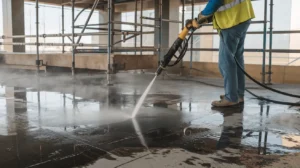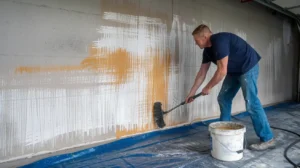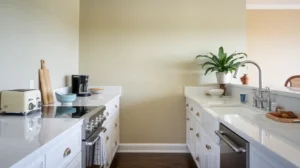Faux granite countertops are an affordable and stylish alternative to real granite. They mimic the luxurious look of natural granite at a fraction of the cost, making them an excellent choice for homeowners looking to upgrade their kitchen or bathroom counters without breaking the bank.
These countertops are available in various forms, from laminate and painted surfaces to epoxy and peel-and-stick versions. In this guide, we’ll explore faux granite, the types available, their pros and cons, how to install them, and how they compare to real granite.

What is a Faux Granite Countertop?
Faux granite countertops are designed to imitate the appearance of natural granite without using the actual stone. They can be made from a variety of materials, such as laminate, paint, epoxy, or contact paper. The goal is to recreate the speckled, multi-toned look of granite while keeping the installation process simple and the costs low.
These countertops can be a DIY project, allowing homeowners to transform their kitchen or bathroom in just a few days. With the right tools and techniques, faux granite for kitchen countertops can look strikingly similar to the real thing, offering a stylish upgrade on a budget.
Types of Faux Granite Countertops
There are several types of faux granite countertops, each with unique benefits and drawbacks. Let’s look at the most popular options:
Laminate Countertops
Laminate countertops are a popular, affordable alternative to granite. Made from a thin plastic laminate material, they feature a printed design that mimics the look of natural stone like granite. This laminate layer is then bonded to a base of particleboard, creating a solid, durable surface.
One of the key benefits of laminate countertops is their cost-effectiveness, making them an ideal choice for budget-conscious homeowners. They also offer a wide range of colors and patterns, allowing for versatile design options. Though not as heat- or scratch-resistant as real granite, laminate countertops are easy to maintain and provide an attractive, practical solution for many kitchens.

Painted Faux Granite
Painted faux granite countertops provide a cost-effective and customizable way to transform your kitchen or bathroom. By using special granite countertop paint kits, you can give your existing surfaces the appearance of natural granite without the high price tag.
These kits typically come with a base coat, several accent colors, and a sealant to protect the finish, allowing homeowners to create a wide range of granite-like patterns and hues. Ideal for DIY enthusiasts, this method allows you to refresh outdated countertops while staying within budget. Plus, it’s an easy way to experiment with different styles.

Epoxy Faux Granite
Epoxy faux granite countertops mimic the luxurious appearance of real granite at a fraction of the cost. The process begins with a base coat applied to the surface, followed by layers of epoxy resin combined with pigments. These pigments are swirled and layered to create the intricate patterns and colors found in natural granite.
Once cured, the epoxy forms a smooth, high-gloss finish that resembles polished stone. Epoxy countertops are not only visually appealing but also highly durable, resistant to moisture, and easy to clean, making them ideal for kitchens and bathrooms.

Contact Paper Countertops
Contact paper countertops offer a simple and cost-effective way to transform the appearance of your kitchen or bathroom surfaces. Made from peel-and-stick material, these faux granite countertops mimic the look of real granite, providing a stylish upgrade without the high cost.
They are lightweight and easy to apply, making them a popular choice for renters or homeowners looking for a temporary solution. Contact paper is applied directly over existing countertops, allowing for a quick refresh without extensive renovations. This option is ideal for those who want a fast, affordable makeover while avoiding long-term commitments.

Pros of Faux Granite Countertops
Faux granite offers several advantages that make them appealing for many homeowners. Here are the top benefits:
Cost-effectiveness
Faux granite for kitchen countertops offer a cost-effective alternative to natural granite, making them an ideal choice for budget-conscious homeowners. Materials such as laminate, paint, or contact paper can mimic the luxurious appearance of granite without the hefty price tag.
Natural granite requires quarrying, cutting, and professional installation, all of which contribute to its higher cost. In contrast, faux granite options are relatively easy to install, saving both material and labor expenses.
Variety of Colors and Patterns
Faux granite offers a vast selection of colors and patterns, making it easy to find a perfect fit for your kitchen or bathroom design. From light, neutral tones to bold, dark shades, faux granite mimics the look of real stone without the high cost.
Whether you’re seeking a subtle, elegant appearance or a more dramatic aesthetic, there’s a faux granite option to match your style. This versatility allows homeowners to achieve the desired look of granite while maintaining flexibility in design choices and budget.
Easy DIY Installation
Faux granite countertops, including painted and peel-and-stick varieties, offer a simple DIY installation. With minimal tools and basic skills, homeowners can achieve a stylish granite look on their own.
This ease of installation makes faux granite an ideal choice for DIY enthusiasts looking to enhance their space without professional help. The process generally involves straightforward steps, making it accessible even for those with limited experience in home improvement projects.
Less Maintenance Compared to Natural Granite
Faux granite countertops offer lower maintenance compared to natural granite, which requires regular sealing to prevent stains and moisture damage. Natural granite is porous and needs sealing to maintain its durability, but faux granite typically does not.
Cleaning faux granite is easy, with no need for specialized sealants or regular upkeep. This makes faux granite a practical option for homeowners who want the aesthetic of granite without the hassle of maintaining natural stone. The reduced maintenance adds convenience and saves time, making faux granite a more user-friendly countertop choice.
Lightweight and Easier to Handle
Faux granite countertops are lighter than real granite, making them simpler to manage and install. This advantage is particularly noticeable with laminate and contact paper options. Their reduced weight means less strain during handling and installation, allowing for quicker and more convenient setup.
This ease of use is ideal for DIY projects or renovations, where heavy materials might pose a challenge. Consequently, faux granite offers a practical alternative for those seeking the look of granite without the associated hassle of handling and installation.
Cons of Faux Granite Countertops
While faux granite offers several advantages, they also have some drawbacks. Here are the main disadvantages to consider:
Durability Issues
Faux granite countertops, often made from laminate or contact paper, lack the durability of natural granite. They are susceptible to scratches, dents, and general wear, which can diminish their appearance and functionality over time. Unlike real granite, which is known for its resilience and long-lasting nature, faux options do not withstand heavy use as well.
Their surface can easily become damaged, making them less ideal for high-traffic areas or heavy-duty tasks. While more affordable, faux granite kitchen countertops may require more frequent replacement or maintenance compared to their natural counterparts.
Lack of Natural Stone Feel
Faux granite can replicate the appearance of real stone but often falls short in delivering the authentic experience of natural granite. Unlike genuine granite, which has a substantial weight and distinct texture, faux granite may feel less solid and authentic.
This difference in feel can be noticeable to those who value the tangible qualities of natural stone, such as its weight and unique surface texture. As a result, faux granite might not fully satisfy individuals seeking the genuine, robust sensation that real granite provides.
Prone to Scratches and Damage
Faux granite surfaces, such as painted or laminate options, are often more susceptible to scratches and damage compared to real granite. These materials can wear down more quickly under heavy use, making them less ideal for high-traffic areas like kitchen counters.
Their durability is limited, and they may not withstand the rigors of daily activities as effectively as genuine granite, which can affect their appearance and functionality over time.
Can Look Artificial Up Close
Faux granite countertops can look impressively realistic from afar, but they might appear artificial when examined closely. The imitation of natural stone often falls short in detail, and the materials used may not fully replicate the intricate patterns and textures of genuine granite.
This discrepancy becomes more apparent up close, revealing subtle flaws and a less authentic appearance. The finish and coloration can sometimes contribute to a synthetic feel, making the difference between real and imitation granite more noticeable upon closer inspection.
May Need More Frequent Replacements
Faux granite countertops, such as those made from contact paper or laminate, often require more frequent replacements compared to real granite. While authentic granite can endure for decades with proper care, faux options may show signs of wear and tear more quickly.
Issues like peeling, scratching, and fading can occur over time, leading to the need for earlier replacement. As a result, while faux granite may offer a more affordable initial option, it often doesn’t provide the same long-term durability and longevity as genuine granite countertops.
How to Install Faux Granite Countertops
Installing faux granite for countertops can be a fun and rewarding DIY project. Here’s a step-by-step guide for a simple installation:
1. Prepare the Surface
To start, clean your existing countertop meticulously to eliminate all dirt, grease, and debris. Use a mild cleaner and cloth, ensuring every corner is addressed. Next, sand down any rough or uneven areas on the surface to achieve a smooth finish.
This preparation step is crucial for ensuring proper adhesion of new materials or coatings, and helps to prevent imperfections that could affect the final appearance and durability of your countertop.
2. Apply the Base Coat
To achieve a faux granite finish, start by applying a base coat of paint or epoxy. This base coat acts as the foundation for your granite look, providing a solid, even surface for the final layers. Choose a color that complements your desired granite effect.
Apply the base coat evenly over the surface, ensuring full coverage. Allow it to dry completely before proceeding to the next step. This drying time is crucial for achieving a smooth, professional-looking finish and ensuring that the subsequent layers adhere properly.
3. Add Colors and Patterns
To add colors and patterns to painted countertops, start by using a paint roller to apply a base color. Then, employ sponges to dab on additional colors, creating varied patterns that resemble granite. For a more authentic look, you can use granite countertop paint kits, which typically include several shades and tools designed to mimic the natural stone’s appearance.
Apply each color in layers, allowing them to blend and create a realistic granite effect. This technique adds depth and texture, enhancing the visual appeal of your countertops.
4. Seal the Surface
After achieving your desired look on the countertop, apply a protective sealant to safeguard it. Sealing creates a barrier that prevents moisture, stains, and scratches from penetrating the surface. This step is crucial for maintaining the countertop’s appearance and longevity, as it enhances durability and simplifies cleaning.
Ensure the surface is clean and dry before application, and follow the sealant manufacturer’s instructions for the best results. Regularly reseal as recommended to keep the countertop in optimal condition and protect your investment.
5. Peel and Stick Installation
Peel and stick installation for contact paper countertops is straightforward, start by removing the backing from the contact paper. Carefully align it with the countertop surface, then press it down firmly.
Use a flat tool, such as a squeegee, to smooth out any air bubbles and ensure a smooth, even application. This method is quick and requires no special tools or adhesives, making it a convenient option for updating countertops.
Maintenance and Care Tips
Faux granite countertops are relatively easy to maintain, but a few tips can help you keep them looking great for longer:
Clean regularly
To maintain your surfaces, clean them regularly using a soft cloth and mild detergent. This helps prevent buildup and keeps the surface looking fresh. Avoid abrasive cleaners or scrubbers, as they can scratch and damage the surface.
Instead, stick to gentle cleaning solutions to preserve the surface’s quality and appearance. Regular cleaning prevents stains and grime from settling, ensuring your surfaces remain in good condition over time.
Avoid excessive heat
Faux granite countertops, like those made from laminate or contact paper, are sensitive to heat. Placing hot pans directly on these surfaces can cause warping, melting, or discoloration. To prevent damage, always use trivets or heat pads when handling hot cookware.
These protective measures will shield the countertop from extreme temperatures and help maintain its appearance and functionality over time. By being mindful of heat exposure, you can extend the lifespan of your faux granite countertop and keep them looking their best.
Repair scratches
To repair small scratches on surfaces, you can use touch-up paint or resin to fill and conceal the damage. For larger or deeper scratches, resurfacing might be necessary. This process involves sanding down the affected area and applying a new layer of material to restore the surface to its original condition.
For best results, ensure the surface is clean and dry before starting the repair. Follow the product instructions carefully and allow sufficient time for drying or curing to achieve a smooth and seamless finish.
Faux Granite vs. Real Granite: Which Should You Choose?
When deciding between faux granite and real granite, consider your budget, lifestyle, and aesthetic preferences. Faux granite is cost-effective, easy to install, and offers a wide variety of styles. However, it may lack the durability and natural feel of real granite.
Real granite, on the other hand, is a long-lasting investment that adds value to your home. It offers a natural, luxurious look and feel that’s hard to replicate. However, it requires regular maintenance and comes with a higher price tag.
Conclusion
Faux granite countertops provide a budget-friendly, stylish alternative to natural granite. With various types available, from laminate and painted surfaces to epoxy and contact paper, homeowners can easily find an option that suits their style and needs.
While there are some durability concerns, the affordability and easy installation of faux granite make it a popular choice for DIY enthusiasts. By weighing the pros and cons and following proper care tips, you can enjoy the beauty of faux granite for years to come. Transform your space with our expert services contact us if you have any query or want to take our services.





